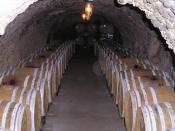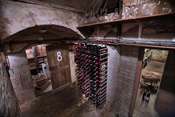A cellar may be humble or grand, large or small. But if it is to qualify for name, it must achieve three things. It should be dark, it should be free of vibration and, above all else, and it should reduce both daily and seasonal temperature variations to a minimum.
Ideal Cellar Conditions The siting, or placement, of your wine cellar within your home is your first major decision. There are four components of ideal cellar conditions: an absolutely constant temperature, varying between neither day and night nor summer and winter; substantial humidity; a very cold mean temperature; and the absence of air movement (let alone any movement of the bottles). The first two factors are of major importance; the third is important but needs to be taken in context, while the last is of least importance, but needs to be mentioned.
Consistency of temperature is more important than the degree of temperature.
Temperature variations is harmful because it leads to the expansion and contraction of the wine in the bottle, hastening the ingress of oxygen - and thereby oxidation.
Ullage is the air space present in a bottle of wine between the cork and the surface of the wine. In old wines it is fairly reliable indication of likely quality: the greater the ullage the more suspect the wine. Excessive ullage indicates a loose cork, widely or frequently fluctuating storage temperatures, or low humidity (Gold 31). Some ullage with age is inevitable, but anything more that 12 mm (1/2 inch) per decade is avoidable.
Excessively high relative humidity inevitably leads to mold. The carbohydrates in your wine cellar: cork stoppers, paper labels, paper surface of the drywall, and wooden shelves can all become mold food (Alexander).
Wines: Best Kept in the Dark When no one is in the cellar,


